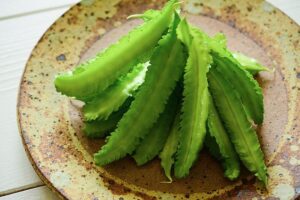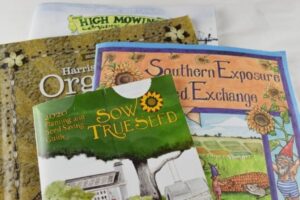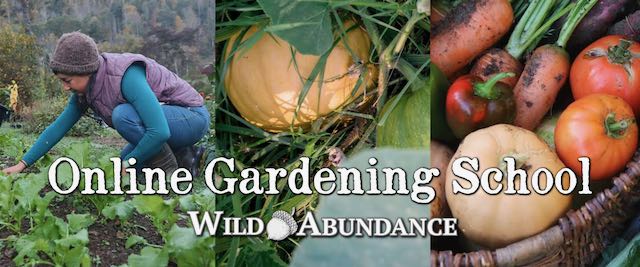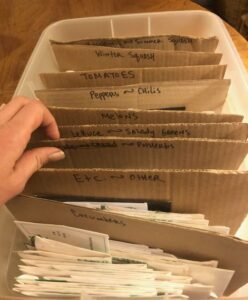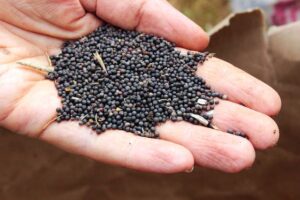All gardens start with seeds (and sun and soil and rain and love, of course). And in this modern age, most of us gardeners will order at least some of our seeds from seed companies. So, to help you order the right amounts of the right seeds for your garden, we’ve put together this guide. Along with ordering, we’ll cover organizing and storing seeds so that they’re easy to find and use, and so that they stay viable over time.
Here’s an overview of our approach to ordering seeds, plus storing and organizing them:
Order in early winter to have access to the greatest variety.
Inventory your seed stash, including age and germination of your seeds.
Consult your garden plan to get a ballpark idea of what you’ll need, and how much.
Try only 1-5 new crops per year so you can really care for and observe them.
Order from small or medium independent seed growers and distributors through catalogues and/or websites.
Store seeds in a cool, dry place, within a plastic tote or other sealed vessel if you live in a humid climate like ours.
Organize seeds in a simple, intuitive way so you’ll be able to access what you need easily come planting time.
Best Time to Order Seeds: Early Winter
Not only is winter usually “down-time” in the garden, it’s also when seed companies offer their new stock of seeds. Growers produce most seeds in the green season (spring, summer, fall). Then, after the seeds are mature, they’re harvested, dried, cleaned, tested for viability and diseases, packaged, and shipped. This means early winter is generally the time when new seed is ready to go, and when seed companies know exactly what they have to offer each year. Especially as interest in gardening and food security increases, seed companies tend to sell out of popular or hard-to-produce varieties very quickly. Order as soon as you’re ready to ensure you get what you’re after.
Inventory Your Seed-Stash
Before you start ordering seeds, take stock of what you’ve got. Don’t just look at crop or variety names, but also look at packed-on dates. Seeds are living organisms that don’t stay viable forever. Many types of seeds can last for years, if they’re stored properly. Others are shorter lived. Keep in mind that exposure to moisture, heat, and light can decrease a seed’s viable life.
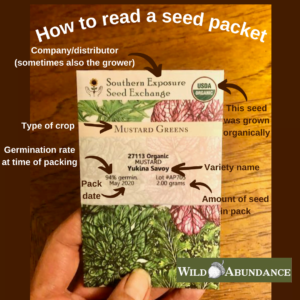

How long do garden seeds last?
Here’s a quick reference that tells you approximately how long different types of seeds will be viable under good storage conditions. We got this information from a more in-depth chart at Johnny’s Selected Seeds here.
- 1 year: onions, parsnips, parsley, salsify, and spinach
- 2 years: corn, peas, beans, chives, okra, dandelion
- 3 years: carrots, leeks, asparagus, turnips, rutabagas
- 4 years: peppers, chard, pumpkins, squash, watermelons, basil, artichokes, cardoons
- 5 years: most brassicas (kale, cabbage, broccoli, etc.), beets, tomatoes, eggplant, cucumbers, muskmelons, celery, celeriac, lettuce, endive, chicory
When in Doubt — Do a Germination Test
Since viability is so dependent on many dynamic factors (like storage and variety), you can always perform a germination test on a batch of seeds. This will tell you not just if the seeds are still viable, but just how viable they are. Low germination rates can inform decisions like composting the seeds and buying a new batch, or just sowing heavily to make up for the lower germination. Here’s a great article on how to perform a germination test from our friends at Southern Exposure Seed Exchange.
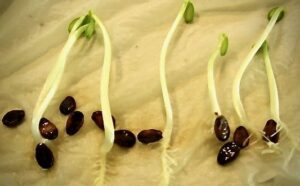

Order Seeds According to Your Garden Plan
Before you order seeds, it will be helpful to have a basic garden plan for the coming year. This doesn’t have to be fully flushed out. Rather, you’ll need a general sense of how much space you’ll be planting and the different kinds of crops and varieties you hope to grow. To learn more about garden planning, and much more, check out our Online Gardening School. It’s a comprehensive, holistic gardening program for anyone who wants to grow food.
To translate your garden plan into the amount of seed you’ll need, here’s a link to a great calculator tool from our friends at Johnny’s Selected Seeds that will help. Keep in mind that there is currently a frenzy around gardening and food security — which is great! In order to support each other, including the seed growers and distributors, and the seeds themselves, we can all cooperate by ordering the number of seeds we will actually need, and not too many more.
Order a Few New Vegetables to Try, but Don’t Go Crazy!
Every year we get excited to try some new crops or new varieties. The seed catalogues are so enticing with their beautiful images and intriguing descriptions; it can be hard to hold back. Even so, we strongly recommend that you limit your explorations to 1-5 new things. This way, you can really pay attention to how your new plant friends grow in your garden. When there are just a few of them, you can tend them well and take good notes without neglecting other plants in your garden or other aspects of your life!
Order Seeds Online or Through Catalogues
Now, once you’re ready to shop for seeds, check out small or medium-sized independent seed companies. These are seed producers and distributors with gardeners, farmers, communities, plants, and seeds guiding their operations, not corporate greed or top-down control of food systems.
Click here for a list of some of our favorite indie garden seed companies.
You’ll be able to buy directly from these companies through their websites or catalogues. Exploring catalogues is especially fun, since you can leaf through them over cups of tea while your wintertime garden imagination runs wild! Do keep in mind that many catalogues are printed before all of the current year’s seed is in; some seeds don’t make it in and can only be found online.
Unless you are averse to online shopping, we recommend doing the actual ordering online, although you can mail-order directly through the catalogues if you prefer. Online ordering is quicker, and you’ll know if anything you’d like to order is already sold out. Plus, you’ll receive an email receipt to keep track of what’s coming.
Storing Seeds for Optimal Viability
Once you receive your seeds, store them in a cool, dry, and ideally dark environment, like a closet or shelf in a corner. In humid environments like ours, a plastic tote or other vessel can be really helpful in maintaining a stable microclimate to keep seeds fresh. As an extra layer of protection against moisture, you can add silica desiccant packets to your seed tote (like the ones that you find in jars of vitamins or packages of sushi nori). If a seed packet happens to get wet, don’t put it back in the container with others and use it as soon as possible.
To learn more about growing and tending over 25 vegetables, herbs, and berries, plus foundational garden knowledge, like seed-saving, pest management, and more, check out our Online Gardening School.
Organize Seeds for Ease of Use
Online Gardening School instructor Chloe likes to organize her seeds by crop (i.e. tomatoes, cucumbers, salad greens, etc.) and by planting time (one tote for summer veggies, another for spring/fall, and others for larger-seeded crops like beans, peas, and grains). She separates sections in her tote with rectangles of recycled cardboard, written on with a marker. It’s simple and cheap, and she likes that! You can create whatever system works best for you to make sure that your seeds are easy to find when you need them.
Growing and Trading — Different Ways to Get Garden Seeds
Ordering seeds online is just one way to get your hands on seeds for your garden. In fact, for most of human history, families and communities grew our own seeds. We’ve also been trading and sharing seeds for a very long time.
These age-old ways to welcome seeds into your garden are still viable options, and both offer much more than simply seeds. Seed saving is a fantastic way to get to know the plants you grow more deeply. You’ll also connect with the cycles of life in a tangible and magical way. On the other hand, organizing a seed swap can provide the opportunity to connect with other gardeners in your local area. Together, you’ll experience the generosity and abundance of the living world, and build relationships with other humans who love plants, too.
Here’s a great guide on How to Organize a Seed Swap, produced by the Seed Savers Exchange. You’ll need to make some COVID-era tweaks, but it’s still totally doable!
How to Save Money on Seeds
If you want or need to save money on your seed order, get together with a group and order in bulk. Many companies have larger packets available at lower prices per ounce, and some offer blanket bulk discounts on larger orders.
Other options for lower or no-cost seeds are:
- Free Seed Project
- Cooperative Gardens Commission Seed Distribution Project
- Seed Savers Exchange
- Community Seed Donations (from Seed Savers Exchange) Please note, this is for school or community garden projects and non-profits only!
- Great American Seed Swap Facebook Group
